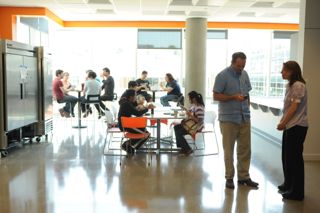New York Times Story About Gates Foundation Office Design Resonates
 isbscience.org/news/2012/03/19/new-york-times-story-about-gates-foundation-office-design-resonates/
isbscience.org/news/2012/03/19/new-york-times-story-about-gates-foundation-office-design-resonates/
This article by Larry Cheek in the March 18, 2012, New York Times describes the trend of creating open office spaces to encourage creativity, movement and collaboration. The idea is that people need different types of spaces to allow for the full potential of different kinds of work. A one-size-fits-all philosophy doesn't function in this day and age when technology and customer service – and healthcare and science where ISB is concerned – focus on a personalized experience. From the article:
These are the main concepts: Buzz — conversational noise and commotion — is good. Private offices and expressions of hierarchy are of debatable value. Less space per worker may be inevitable for cost-effectiveness, but it can enhance the working environment, not degrade it. Daylight, lots of it, is indispensable. Chance encounters yield creative energy. And mobility is essential.
And this:
Seattle serves as a test tube because of several converging factors: There’s a lot of money here to experiment with projects. The work force is relatively young and open to innovation. And the local culture places a high value on informality, autonomy and egalitarianism. People will put in long hours under high pressure if they feel respected, but they won’t tolerate being treated like Dilberts.
This ethic certainly resonates with ISB. Systems biology is based on the idea of knocking down traditional walls between disciplines. It takes purposeful and spontaneous collaborations to innovate and the workspace needs to accommodate this kind of engagement.
Before we moved into our South Lake Union location in April 2011, we had the chance to work with Perkins+Will and BNBuilders to design our workspace to reflect our founding principles. The bright colors were shocking to some initially, but we feel the atmosphere is lighter and appeals to creativity and innovation. Our design team has already received recognition for its work:
The IIDA (International Interior Design Association) Design IN Mass Award: We were winner in class for "tenant improvement."
The American Institute of Architects' Building Information Model Award: We received an honorable mention in the "Delivery Process Innovation" category.
In addition to these honors, we are on track to receive LEED Platinum certification, which is the highest designation a building can receive. LEED stands for Leadership in Energy and Environmental Design and is administered by the U.S. Green Building Council. ISB will be the second biomedical research facility to receive Platinum certification in the world.




